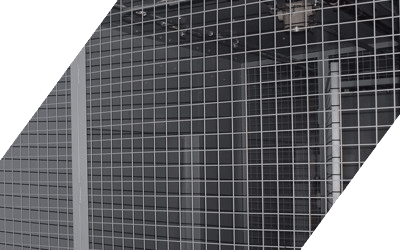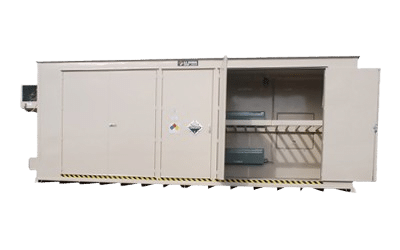Flammable & Combustible Storage Solutions
Following the codes for storing flammable and combustible liquids and other hazmat is critical for keeping operations running safely and efficently. U.S. Chemical Storage offers solutions for all sizes of facilities to keep you in compliance.

Both fire-rated and non-fire-rated construction is available. A hazardous material (hazmat) is any substance or agent that can cause harm to individuals, animals or the environment or any item that can cause a health hazard or physical hazard.
Flammable materials can ignite easily at lower temperatures, typically below 37.8°C (100°F), making them highly hazardous, while combustible materials require higher temperatures (between 37.8°C and 93.3°C) to catch fire.
This difference in flash points means that flammable substances, such as petrol and acetone, can produce ignitable vapors quickly, whereas combustible materials like diesel and paint thinner need more heat to generate such vapors. Understanding these distinctions is essential for effective storage and material handling systems.
For more information in the distinction, read the NFPA article “What is an Ignitable Liquid and How is it Classified?”
Flammable & Combustible Material Storage Buildings
Flammable liquids have strict codes by OSHA limiting how much can be stored and where it must be stored. Fire codes from the NFC and NFPA have specified the use of “Chemical Storage Lockers” – which are prefabricated chemical storage buildings like those made by U.S. Chemical Storage. Our fire-rated buildings are designed specifically to meet these codes for your operation.
Flammable Chemicals Storage
Flammable liquids should be stored in NFPA-approved structures that are labeled clearly. Self-closing mechanisms in the event of fire are ideal. Climate control is a must for maintaining ideal conditions, and they must be protected from direct sunlight and other heat sources. Proper ventilation is necessary, which could be in the the form of mechanical ventilation or forced fan.
Combustible Materials Storage
While they have a higher flashpoint, these chemicals still require ideal environments for them. They require many of the same conditions that flammable chemicals require: ventilation, away from heat sources, and climate control.
With both types of materials, it is important to keep incompatible materials segregated. Additional rooms within the same building can achieve this, or two separate buildings. Always consult your Safety Data Sheet (SDS).
Code Concerns
The National Fire Protection publishes the Flammable and Combustible Liquids Code, which includes the storage of hazardous materials in lockers. Chapter 12 specifically provides guidance in storage in lockers – which in this case does not mean cabinets, but prefabricated structures that are built to suit this very purpose.
- Designated placement and spacing
- How many buildings can be permitted
- Public access and security concerns
- Egress and general designs
Features & Benefits
- 100% customizable
- Durable steel construction ensures structural integrity
- EPA compliant containment sump
- Mixing and dispensing rooms available
- 15-year structural warranty
- Acrylic alkyd enamel with an epoxy paint upgrade available
- Modular solutions available for larger footprints
- Code-calculated secondary containment sumps
U.S. Chemical Storage is experienced in the codes, the individual state requirements, and the safety features necessary to get projects approved by your AHJ (Authority Having Jurisdiction).
Frequently Asked Questions
The definition of a “sump” is a pit or reservoir providing containment for spilled liquids. U.S. Chemical Storage offers leak-proof spill containment sumps in each standard model. All our sumps are tested for leaks for a 24-hour period prior to finishing. The sump is then covered by a steel or fiberglass floor grating and can even be equipped with a resistant plastic sump liner to protect against corrosive chemical accidental spills. The size of the sump is dictated by code based on the volume of liquid being stored within the building.
Building size is determined by the amount of hazardous material you are planning to store, the need for occupancy or inspection around these materials, and must take into consideration the most efficient way of moving these materials into and out of your chemical storage building.
Start by speaking with one of our experienced Technical Sales Engineers to learn about the needs of your application. They will want to know what type of chemicals you are storing? How much of it will you be storing? What proximity to other buildings, people, egress paths, or environmental features will it need to be? Do you require special spill containment?
And from there they’ll ask any related questions that determine additional options; Material Handling – Climate Control – Ventilation – Occupancy – Lights – Sensors – Alarms – Door Styles – Eyewash Stations and other requirements are not uncommon. Answers to these questions will dictate the building’s fire rating construction as well as anything else you’ll need for proper code compliance.
Chemical storage buildings manufactured by U.S. Chemical Storage are designed to get your operation compliant. Contact one of our technical sales engineers to learn how we can find the best solution for your compliance needs.
You will also want to learn more about specific chemical storage requirements in your specific area by contacting your local “Authority Having Jurisdiction” (AHJ) who could be a local fire marshal, a municipal code official, or a city environmental department.
Request a Quote
RELATED PRODUCTS
ChemLoc™ Chemical Storage Buildings
For unparalleled protection, use non fire-rated hazardous chemical storage buildings for storing flammable or combustible chemicals at least 30 feet from other buildings. These chemical storage units have countless applications and accessories that can be custom engineered to fit your specific needs. View Product >Climate Control Options for Your Storage Building
U.S. Chemical Storage offers a full line of climate control chemical storage building options to store chemicals within their distinct favorable temperature range. View Product >Partition
Walls
Segregating chemicals with partition walls allows for the storage of multiple chemicals inside the same chemical storage building.
View Product > Racks
and Shelves
Let U.S. Chemical Storage help you get organized with a full line of storage racks and shelves to keep your chemicals sorted.
View Product > 
YOUR PARTNER IN THE PROCESS. EXPERIENCE YOU CAN TRUST.
We deliver the precise building solution with the speed, security, and high quality that you demand.





